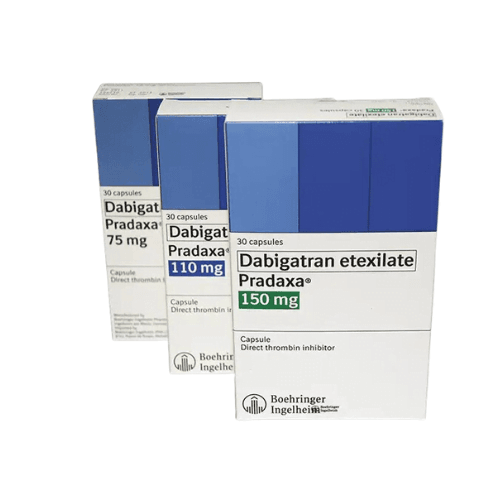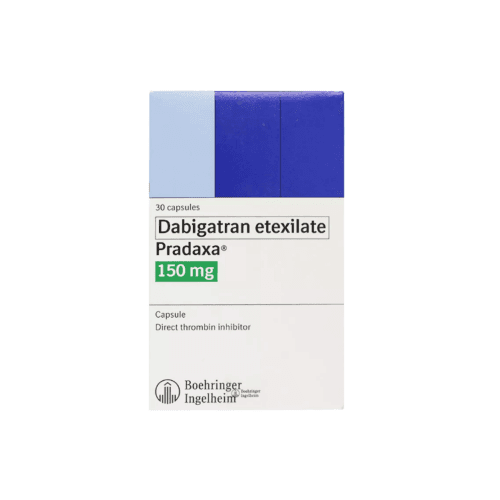Shipping with this method takes 3-5 days
Pradaxa® Capsules for Stroke Prevention in AFib
Stock up and Save - Get 20% off when you buy 3 or more of any one product. Use code SAVE20 at checkout.
Coupon code cannot be combined with other offers. Sale applies to all products originating from Canada. Maximum allowable quantity equal to a 90 day supply per single order.
Price range: $70.99 through $108.99
Secure Encrypted Payments
What Pradaxa Is and How It Works
Dabigatran is an oral anticoagulant used to help prevent harmful blood clots. It is commonly prescribed to reduce stroke risk in nonvalvular atrial fibrillation and to treat or prevent deep vein thrombosis and pulmonary embolism. This page explains how the therapy works, who it suits, and how to use it safely. It also helps you compare options with US delivery from Canada and understand typical costs without insurance.
Pradaxa® is the reference brand for dabigatran etexilate, a direct thrombin inhibitor. After activation in the body, it blocks thrombin, a key enzyme that allows fibrin clot formation. By limiting thrombin activity, the treatment lowers the chance of clots forming or growing. YouDrugstore is a licensed Canadian pharmacy in Manitoba. Pharmacists review prescriptions before dispensing.
This medicine is part of the DOAC class, which often requires no routine INR checks. Some people may still need periodic labs based on kidney function and overall risk. Always follow your prescriber’s advice and the official label.
Who It’s For
The treatment is indicated to reduce the risk of stroke and systemic embolism in adults with nonvalvular atrial fibrillation. It is also used for the treatment of DVT and PE, and to reduce the risk of recurrent DVT and PE following initial therapy. People with mechanical heart valves should not take this medicine.
Those with severe kidney problems, active bleeding, or certain bleeding disorders may not be candidates. If you have a recent spinal procedure, a gastric ulcer, or liver disease affecting coagulation, discuss risks with a healthcare professional. Use during pregnancy or breastfeeding requires medical guidance.
Dosage and Usage
Capsules are swallowed whole with water, with or without food. Do not open, crush, or chew them. Doses vary by indication and kidney function. Many adults take the medicine twice daily on a consistent schedule. If you are unsure of your prescribed regimen, check the product monograph or ask your prescriber.
Take doses at the same time each day. If heartburn occurs, a light snack may help, but do not alter capsule integrity. If transitioning from or to another anticoagulant, your clinician will advise on timing to maintain continuous protection. See the Pricing section for Pradaxa 150 mg cash price details.
Strengths and Forms
Oral capsules are the standard presentation. Commonly published strengths include 75 mg and 150 mg. Availability can vary by manufacturer and market. Your prescriber will choose a strength based on indication, kidney function, age, and bleeding risk.
Missed Dose and Timing
If a dose is missed, take it as soon as you remember on the same day. If it is nearly time for the next dose, skip the missed one and resume your regular schedule. Do not double up doses. Keeping a medication reminder can support steady adherence.
Storage and Travel Basics
Store capsules at room temperature in the original package to protect from moisture. Keep away from excess heat and direct light. Do not place capsules into pill organizers that expose them to humidity for long periods. If traveling, carry your prescription label and keep the medicine in your hand luggage. Use a child-resistant container and keep out of reach of children and pets.
Pen Handling and Sharps Disposal
This therapy is taken by mouth and does not use pens or needles. Dispose of empty blister packs or bottles in household waste unless local rules advise otherwise.
Benefits
This class provides predictable anticoagulation without routine INR monitoring for most adults. Twice-daily dosing supports steady levels in the body. Capsules allow simple administration compared with injections. The medicine can help lower the risk of stroke in AFib and treat or prevent DVT and PE when used as directed.
Side Effects and Safety
- Common effects: stomach discomfort, heartburn, indigestion, or nausea
- Other effects: easy bruising or minor bleeding like nosebleeds or gum bleeding
Serious but less common risks include major bleeding or gastrointestinal bleeding. Seek urgent care for black stools, vomiting blood, severe headache, dizziness, or unusual weakness. The risk of bleeding may be higher with age, kidney impairment, or when combined with other medicines that affect clotting.
Drug Interactions and Cautions
Drugs that increase bleeding risk may interact, including antiplatelets, NSAIDs, other anticoagulants, SSRIs/SNRIs, and some herbal products like ginkgo or garlic. P-gp inhibitors or inducers can affect levels; examples include ketoconazole, amiodarone, verapamil, rifampin, and carbamazepine. Alcohol can raise bleeding risk. Tell your clinician about all medicines and supplements before starting or stopping therapy.
What to Expect Over Time
Effects are not felt like pain relief; the benefit is reduced clot risk over consistent use. Minor bruising or mild stomach symptoms can occur early and may improve. Keep scheduled follow-ups so your prescriber can review kidney function, bleeding risk, and adherence. Questions about Dabigatran 150 mg cost are common over long courses; see Pricing for guidance and alternatives.
Before planned surgery or dental work, clinicians may instruct a temporary hold to lower bleeding risk. Do not stop on your own. Missing several doses may increase clot risk.
Compare With Alternatives
Other DOACs are options when appropriate. Rivaroxaban is a once-daily factor Xa inhibitor; see Xarelto for more information. Warfarin remains a valid choice for certain indications, including mechanical valves and severe kidney impairment; learn more at Warfarin. Discuss which agent aligns with your medical history and monitoring preferences.
For background reading, explore Types Of Anticoagulant Drugs and this comparison article Pradaxa Vs Eliquis. If you are managing AFib, our condition pages for Atrial Fibrillation and Blood Clot DVT PE provide additional context.
Pricing and Access
We list transparent options so you can review the Pradaxa 150 mg price and compare across available manufacturers. You will also find the Generic dabigatran 150 mg price where stocked. Because we operate with Canadian pricing, many patients see lower out-of-pocket costs than typical local cash rates. Look for current listings before placing an order.
For broader category browsing, visit Cardiovascular. If you use coupons, check our seasonal page at Promotions. Ordering includes US shipping from Canada with secure processing.
Availability and Substitutions
Supply can vary by strength, manufacturer, and packaging. If a specific pack is unavailable, a prescriber may recommend a therapeutically appropriate alternative. When clinically suitable, Dabigatran 150 mg from Canada may be substituted for the brand. We cannot confirm restock timing here; check back or ask your clinician about other options if needed.
Patient Suitability and Cost-Saving Tips
Good candidates include adults with nonvalvular AFib who need stroke risk reduction, and those treated for DVT or PE. People with mechanical valves, active bleeding, or severe kidney impairment typically need different management. If you have moderate renal issues or are over 75, your prescriber will weigh bleeding risk carefully.
- Multi-month fills: fewer refills, potential savings
- Refill reminders: avoid missed doses
- Keep original packaging: maintains capsule integrity
- Travel prep: carry scripts and a med list
To compare options and budgeting, use resources that let you Compare Pradaxa 150 mg prices in context with generics and other DOACs. If your insurance changes, revisit choices at renewal. Our checkout is encrypted for your privacy.
Questions to Ask Your Clinician
- My indication: what dose and schedule are right for me?
- Bleeding risk: what warning signs should prompt urgent care?
- Kidney function: how often should it be checked?
- Procedures: how should I plan for surgery or dental work?
- Other drugs: which medicines or supplements should I avoid?
- Gastro symptoms: how can I manage heartburn without affecting therapy?
Authoritative Sources
See official information for complete indications, cautions, and administration details:
Availability and Next Steps
Ready to proceed? Place your order with YouDrugstore for prompt US shipping from Canada. Temperature-controlled handling when required. This information is educational and does not replace your prescriber’s advice or the official label.
Express Shipping - from $25.00
Prices:
- Dry-Packed Products $25.00
- Cold-Packed Products $35.00
Shipping Countries:
- United States (all contiguous states**)
- Worldwide (excludes some countries***)
Standard Shipping - $15.00
Shipping with this method takes 5-10 days
Prices:
- Dry-Packed Products $15.00
- Not available for Cold-Packed products
Shipping Countries:
- United States (all contiguous states**)
- Worldwide (excludes some countries***)
Can dabigatran be taken with food or antacids?
You can take dabigatran with or without food. If heartburn occurs, a light snack may help. Do not open or crush the capsules. Some antacids and acid-reducing agents can be used, but strong P-gp inhibitors or certain medicines may interact. Separate general antacids by at least a couple of hours if advised by your clinician. If reflux symptoms persist or worsen, speak with a healthcare professional before adding new over-the-counter products.
What should I do before surgery or dental work?
Tell your surgeon or dentist that you take this anticoagulant. Your clinician may plan a temporary pause before procedures to reduce bleeding risk. The timing depends on kidney function and the type of procedure. Do not stop the medicine without guidance. After the procedure, your prescriber will advise when to restart. Keep all instructions in writing and use reminders so you do not miss doses inadvertently.
Do I need routine blood tests while on dabigatran?
Routine INR monitoring is not required with this therapy. Your clinician may still check kidney function and other labs at intervals, especially in older adults or those with renal impairment. If bleeding events occur, they may order specific tests. Keep scheduled appointments, and report any concerning symptoms promptly so your plan can be adjusted as needed.
How is dabigatran different from warfarin?
Dabigatran directly inhibits thrombin and usually does not require INR monitoring. Warfarin reduces vitamin K–dependent clotting factors and needs regular INR checks and dietary consistency. Some patients still use warfarin due to mechanical valves, severe renal impairment, or cost considerations. Your clinician can help decide which option fits your medical history and local monitoring resources.
What increases bleeding risk while taking this medicine?
Combining with NSAIDs, antiplatelets, other anticoagulants, SSRIs or SNRIs, or certain herbs can raise bleeding risk. Heavy alcohol use can also contribute. Falls, stomach ulcers, kidney problems, and older age add to risk. Let your healthcare professional review all medicines and supplements. Seek immediate care for signs like black stools, coughing blood, severe headache, or unusual weakness.
What if I miss a dose of dabigatran?
If you miss a dose, take it as soon as you remember on the same day. If the next dose is due soon, skip the missed dose and resume your regular schedule. Do not take two doses together. Using a pill organizer that keeps capsules dry and setting phone reminders can help you stay on track. If you miss multiple doses, contact your prescriber for guidance.
Is dabigatran safe with kidney or liver problems?
Kidney function strongly influences dosing and suitability. People with severe renal impairment may need adjustments or a different anticoagulant. Significant liver disease affecting clotting also warrants caution. Your clinician will review labs before starting and during treatment. Never change the dose yourself; follow the product label and your prescriber’s plan to balance clot prevention and bleeding risk.



